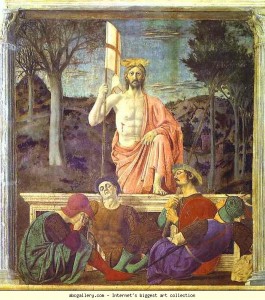Josephus tells us that the Romans did not expect their subjects to violate their national laws (Against Apion 2.73) ; furthermore, he is explicit that the Romans did not expect the Jewish people to leave a corpse unburied (Against Apion 2.211).Under Jewish custom, the Sanhedrin would have been obligated to bury Jesus before sundown (Deuteronomy 21v22-23; m.Sanh 6 5-6; Semahot 13.7; 11QTemple 64.7-13a=4Q524 frag.14 lines 2-4) They had sought Jesus execution; to have left his body on a tree would have “polluted” the very land they were trying to save. So the burial of Jesus by a member of the Sanhedrin is very plausible (See: Craig Evans (2012), Jesus and His World, p.136-40).
Jesus’ followers would have had to have taken note of his burial place so that they could mourn him properly. Furthermore, according to Jewish custom, they would have had to return to the primary burial site one year later to collect their masters bones for an honorable burial. There would have been little mystery about Jesus burial place. Unless it was known that there was an empty tomb where Jesus’ dead body was meant to lie, it is very unlikely that the claims of the first disciples would have cut much ice in Jerusalem. If the first Christians believed that Jesus had been resurrected, there would have been some curiosity about the place where he had been buried. And if the Jerusalem authorities were prepared to endorse Paul’s zealous persecution of the Church, it is likely that they were prepared to check on Joseph’s tomb to see if it was occupied!
We have to ask why the earliest churches would invent a story in which women discover the empty tomb, while the honourable male leaders of the church hid in doubt and fear. Granted, women were important to the first churches. If the Gospel writers were trying to elevate the status of women in the church they would not have made the women seem so confused, incompetent and unheroic. However we look at Mark 16, these women do not emerge as ideal eyewitnesses! Furthermore, a woman’s testimony would not be taken seriously by outsiders; it had no value in court. It would have been tremendously embarrassing to admit that the first witnesses to the events of Easter were women!
If this story is an invention of an early apologist we have to ask why he was so extraordinarily incompetent. A child could have created a story that would have been easier to sell to the wider culture. Why not invent a story in which a male follower visited Jesus’ burial place, to be told by an angel not to mention this empty tomb to anyone? After all, the angel could argue that there was a danger of the Church worshipping at the tomb; because Jesus was no longer there such worship would have been inappropriate. We also have to ask why the Church would create a story in which Jesus was buried in Joseph of Arimathea’s tomb. This man was a member of the Sanhedrin; the very group that had conspired to execute Jesus. It is difficult to believe that the Church would give credit to such a man unless he actually deserved it.
Above all, if you’re trying to “bend the truth” a little, you don’t create facts that are easy to check. And it would have been easy for the residents of Jerusalem to check if Joseph had used a family tomb for Jesus’ burial. He could confirm, or deny, that the tomb was empty. If the Church had “lost track” of Jesus body, it could simply have spread the story that Jesus had been buried in a pauper’s grave. The poor were buried in unmarked patches of land. Losing track of Jesus’ burial place would have been understandable in such circumstances. Jesus had suffered the most shameful death imaginable, so there was little to be lost by saying that he had been buried with the poor. In fact, there seems to be very good sermon material in that sort of story!
Finally, Matthew’s[1] Gospel has to respond to the charge that the disciples stole Jesus’ body. Now grave robbing was associated with witchcraft, so this was a serious accusation. Matthew would not have included it in his Gospel lightly. This seems to have been the standard Jewish response to the Easter message, and Matthew could not ignore it. So it is interesting to see what Jew and Christian were agreed on. Both parties agreed that Jesus was buried in Joseph of Arimathea’s tomb. They agreed that disciples were at the tomb on Easter morning. And they agreed that this tomb was empty. We would expect Jesus’ friends and enemies to check on the status of his body. And, by itself, there is nothing miraculous about a missing body. This is not a claim that requires extraordinary evidence. So the classical scholar Michael Grant, who did not believe in the resurrection, argued that:
..the historian … cannot justifiably deny the empty tomb. True, this discovery, as so often, is described differently by the various Gospels – as critical pagans early pointed out. But if we apply the same sort of criteria that we would apply to other ancient literary sources, then the evidence is firm and plausible enough to necessitate the conclusion that the Tomb was empty.[2]
The Jewish historian Geza Vermes, who like Grant does not believe in the resurrection, also believes that: “the women who set out to pay their last respects to Jesus found to their consternation, not a body, but an empty tomb”.[3]Both Grant and Vermes find the reports of the women’s testimony to the empty tomb to be particularly persuasive. It just seems wildly implausible that the Church would invent a story about women discovering the empty tomb; especially when one of those women, Mary of Magdala, was once believed to be demon possessed.
If we can safely conclude that Jesus’ followers had experiences of his presence after his death, we can also safely conclude that Jesus’ tomb was inspected and found to be empty. We also know that those who witnessed the risen Christ were convinced that he had been “resurrected”. If the Church was in the habit of inventing stories it had a wide range of concepts to draw on; and the Church could have invented a story that was impossible to falsify. They could have preached that Jesus’ spirit was yet alive at the Father’s right hand, and that he would be reunited with his body on the last day, when God would proclaim him Messiah. It would have been impossible for Jesus’ enemies to prove such a message was wrong.
————————————————————————————————————————————————————————————–
[1] Sometimes Matthew’s report that the dead left the tombs and that the Temple curtain split upon Jesus’ death is taken as evidence that subsequent generations embellished simpler accounts of the Resurrection. This ignores the fact that Luke and John’s accounts are less “extravagant” than Matthew’s. It also fails to compare Matthew’s Resurrection narrative to Josephus’ account of the signs that accompanied the fall of the Temple, or Dio Cassius’ account of Claudius’ death. Matthew is positively restrained by comparison! No-one doubts that the Temple fell to the Romans, even though Josephus feels compelled to use apocalyptic language in his history.
[2] Michael Grant, Jesus (London: Phoenix, 1999), 176. It is significant that, while Mark knows of resurrection appearances, (eg. Mark 8v31) he chooses to end his Gospel with an empty tomb. The empty tomb explains what Jesus meant by his earlier statements about rising again; it gives content to Mark’s concept of resurrection.
[3] Ibid.



